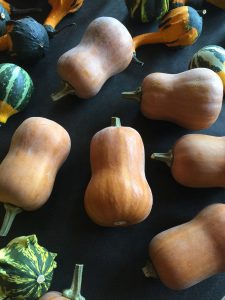At Amy Goldman’s Farm, a Plethora of Pepos
Posted in Learning Experiences on October 31 2016, by Todd Forrest
Todd Forrest is NYBG’s Arthur Ross Vice President for Horticulture and Living Collections. He leads all horticulture programs and activities across the Garden’s 250-acre National Historic Landmark landscape, including 50 gardens and plant collections outside and under glass, the old-growth Thain Family Forest, and living exhibitions in the Enid A. Haupt Conservatory.
 For 47 years, 4 months, and 20 days, I just didn’t know enough about pepos. “What’s a pepo?” you might ask. Pepo is the botanical term for the fruit of plants in the Cucurbitaceae (gourd family). Sure, I knew a little about pumpkins, spaghetti squash, butternut squash, zucchini, and cucumbers. I had eaten Hubbard, acorn, and delicata squash grown, harvested, roasted, and slathered in butter by my brother-in-law, a gourmand who farms in coastal Maine. I even knew that the luffa defoliators my fresh-faced friends swear by are made from the dried fibrous flesh of a gourd relative native to Africa.
For 47 years, 4 months, and 20 days, I just didn’t know enough about pepos. “What’s a pepo?” you might ask. Pepo is the botanical term for the fruit of plants in the Cucurbitaceae (gourd family). Sure, I knew a little about pumpkins, spaghetti squash, butternut squash, zucchini, and cucumbers. I had eaten Hubbard, acorn, and delicata squash grown, harvested, roasted, and slathered in butter by my brother-in-law, a gourmand who farms in coastal Maine. I even knew that the luffa defoliators my fresh-faced friends swear by are made from the dried fibrous flesh of a gourd relative native to Africa.
The little I thought I knew about pepos could never have prepared me for the bounty of beauty I encountered when I made the journey, with a group of NYBG trustees and staff members, to NYBG Board Member Amy Goldman Fowler’s farm in the Hudson Valley one glorious October day. Amy has raised the art and science of growing vegetables to a level unimaginable to those of us who tinker in backyard plots. With the discipline of a research scientist and the passion of an artist, Amy grows a bewildering selection of melons, squash, pumpkins, and gourds (not to mention tomatoes and peppers and who knows what else) on her farm each year.

